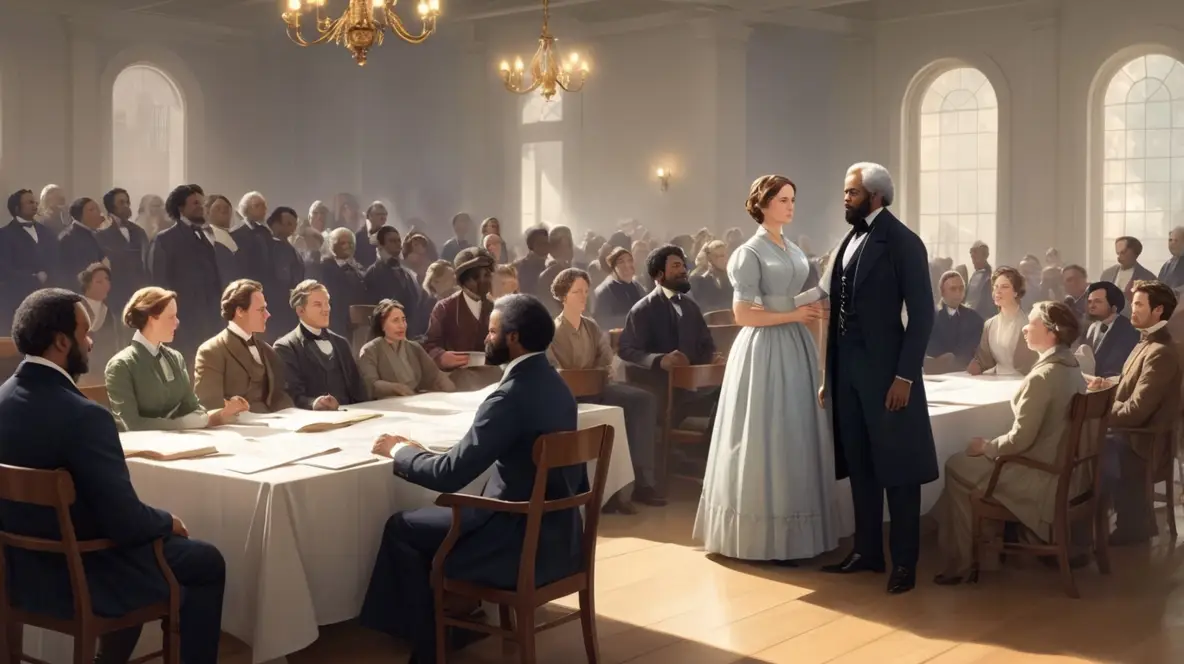Seneca Falls Convention
The Seneca Falls Convention: A Turning Point in Women’s Rights
The Seneca Falls Convention of 1848 marked a pivotal moment in the fight for women’s rights. Held in Seneca Falls, New York, this historic event brought together prominent activists to address the inequalities women faced and sparked the movement for women’s suffrage. The ideas and resolutions discussed during this convention laid the foundation for future gender equality reforms in the United States.

[su_box title=”Seneca Falls Convention – Next years” box_color=”#fb0400″]
- Saturday, 19 July 2025
- Sunday, 19 July 2026
- Monday, 19 July 2027
- Wednesday, 19 July 2028
[/su_box]
What Was the Seneca Falls Convention?
The Seneca Falls Convention was the first women’s rights convention in the United States, organized to discuss the social, civil, and religious rights of women. Held on July 19-20, 1848, it was attended by approximately 300 people, both men and women, who sought to challenge the status quo of the time.
The Organizers Behind the Event
The convention was spearheaded by prominent figures like Elizabeth Cady Stanton and Lucretia Mott, who had long been advocates for social reform, including abolitionism and temperance. Their desire to address the broader issue of women’s rights stemmed from the belief that women should have equal access to opportunities, legal standing, and personal freedoms as men.
The Declaration of Sentiments
The heart of the convention was the Declaration of Sentiments, a document modeled after the Declaration of Independence. Written primarily by Elizabeth Cady Stanton, it outlined the grievances women faced and demanded their rights.
Key Grievances in the Declaration
- Lack of Voting Rights: Women were denied the right to vote, leaving them voiceless in political matters.
- Limited Educational Opportunities: Access to education was restricted, preventing women from pursuing intellectual and professional growth.
- Inequality in Marriage: Married women had few legal rights, with their husbands controlling property, earnings, and decision-making.
- Exclusion from Public Life: Women were often barred from participating in public discourse, leadership roles, and religious activities.
The Impact of the Declaration
The Declaration of Sentiments was a revolutionary document that called for radical changes, including women’s suffrage. While the document was met with resistance, it laid the groundwork for future advancements in women’s rights and became a symbol of the women’s suffrage movement.
The Role of Men at the Convention
Although the convention focused on women’s issues, men were also present and played a crucial role. One of the most notable male attendees was Frederick Douglass, an abolitionist and advocate for women’s rights. His support for the resolutions, particularly the right to vote, was instrumental in gaining broader acceptance of the ideas discussed at the convention.
Resolutions Passed at the Convention
During the two-day event, 12 resolutions were presented and debated. The attendees voted on these resolutions, which aimed to address various social and legal inequalities faced by women.
Key Resolutions
- Equal Rights in Education and Employment: Women should have the same opportunities as men to receive an education and pursue careers.
- Right to Vote: One of the most controversial resolutions called for women’s suffrage—the right for women to participate in elections and have a voice in government.
- Legal Rights for Married Women: Women should have the legal right to own property, keep their earnings, and have a say in decisions regarding their families.
Opposition to Women’s Rights
Despite the passion and determination of the attendees, the Seneca Falls Convention was met with significant opposition. Many saw the demands for voting rights and gender equality as too radical and unrealistic. Newspapers and public figures ridiculed the idea of women’s suffrage, claiming it went against the natural order of society.
The Aftermath of the Seneca Falls Convention
Although the convention did not result in immediate changes, it set the stage for a more organized and widespread women’s rights movement. Activists like Susan B. Anthony, who joined the fight after the convention, continued to push for women’s suffrage and equality.
The Long Road to Women’s Suffrage
The call for women’s suffrage in 1848 was just the beginning. It would take over 70 years before women won the right to vote with the passage of the 19th Amendment in 1920. The efforts of countless women, including those inspired by the Seneca Falls Convention, were crucial in achieving this monumental victory.
The Legacy of the Seneca Falls Convention
The Seneca Falls Convention holds a significant place in American history. It was a catalyst for change, inspiring future generations of feminists and activists to continue the fight for gender equality. The ideals expressed during the convention are still relevant today, as the push for equality continues worldwide.
Commemorating Seneca Falls Today
In recognition of its historical importance, the Seneca Falls Convention is remembered and celebrated as a key event in the fight for women’s rights. The Women’s Rights National Historical Park in Seneca Falls stands as a tribute to the brave individuals who took a stand in 1848 and paved the way for future advancements in women’s rights.
A Milestone for Equality
The Seneca Falls Convention was more than just a meeting—it was the start of a movement that would eventually change the course of history. The issues discussed and the resolutions passed in 1848 laid the groundwork for decades of activism that ultimately led to greater rights for women. While the fight for gender equality is ongoing, the legacy of the Seneca Falls Convention remains a beacon of hope and progress in the journey toward true equality.
5 Frequently Asked Questions (FAQs)
- What was the Seneca Falls Convention?
The Seneca Falls Convention, held in 1848, was the first women’s rights convention in the United States and a pivotal event in the women’s suffrage movement. - Who organized the Seneca Falls Convention?
The convention was organized by women’s rights activists Elizabeth Cady Stanton and Lucretia Mott, along with other key figures in the movement. - What was the Declaration of Sentiments?
The Declaration of Sentiments was a document modeled after the Declaration of Independence that outlined the grievances faced by women and called for their rights, including the right to vote. - What was the significance of Frederick Douglass at the convention?
Frederick Douglass, a prominent abolitionist, supported the women’s rights movement and played a key role in advocating for the resolution on women’s suffrage. - What is the legacy of the Seneca Falls Convention?
The convention is remembered as a milestone in the fight for gender equality and laid the foundation for future advancements in women’s rights, including the passage of the 19th Amendment.


